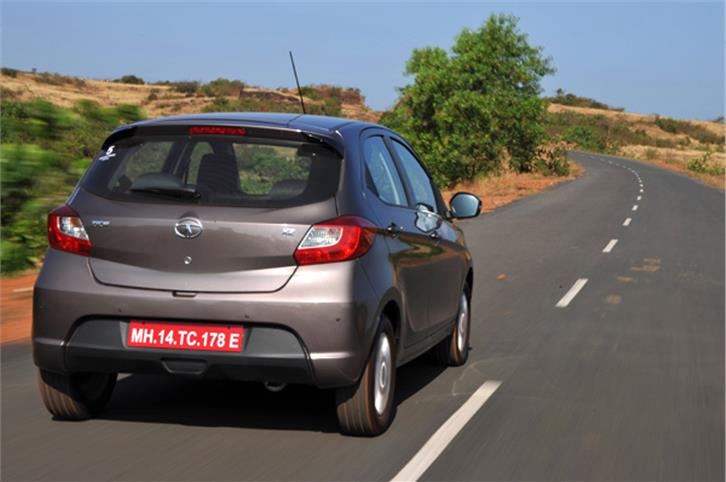Tata Tiago review, test drive
Tata Motors has put its heart and soul in to the all-new Tiago which sets some new benchmarks in the segment. But is that enough to win customers?
Published on Mar 14, 2016 11:47:00 AM
2,86,601 Views
Follow us on



What is it like to drive?
Not only is the Tiago new inside and out, it also happens to be the launch vehicle for Tata’s new three-cylinder petrol and diesel engines. Both engines come mated to five-speed manual gearboxes though automated manual transmission options will be offered in the future.
The 1.2-litre Revotron petrol engine is a grounds-up design and uses lightweight all-aluminium construction, a four valve per cylinder DOHC setup and variable cam timing for the intake. It’s an undersquare engine with bore and stroke measuring 77mm and 85.8mm respectively. Peak power is 83.8bhp (at 6,000rpm) while max torque of 11.6kgm is produced at 3,500rpm.
Respectable as the above numbers are, the petrol Tiago isn’t a very lively performer. The engine doesn’t rev particularly quickly and performance is adequate and no more. The feeling is that you always have to work the engine to bring out its best; a tall third gear only makes this more evident in slow moving city traffic. In stop-go traffic, you’ll also notice power delivery to be jerky. You can sense the fuel cut off the moment you lift off the throttle. The clutch is light, but not very progressive, and the gearbox also requires effort to slot in at times. Refinement levels are fair at low revs though the thrum from the three-cylinder engine can get intrusive, especially at the 3,000rpm mark when a bit of resonance filters into the cabin.
There’s also a bit of a judder just after you engage the clutch and floor the throttle.
To be honest, it’s the three-cylinder Revotorq turbo-diesel engine that seems a lot nicer. This 1.05-litre engine is actually a downsized (and thoroughly modernised) version of the Indica’s 1405cc, four-cylinder diesel unit. The block is cast iron while the aluminium head houses twin cams and four valves per cylinder. The engine’s 69bhp at 4,000rpm and 14.27kgm from 1,800-3,000rpm make it far more powerful than the Celerio’s two-cylinder diesel unit.
Start the engine and there’s no escaping this is a small displacement three-cylinder motor. There are vibrations but it’s not all that bad. The engine also takes time to wake up but builds speed reasonably well from about 1,500rpm though the real power comes in only post 1,800rpm. Thereon, the engine pulls sufficiently but again it doesn’t feel particularly peppy. That’s to say it gets the job done but doesn’t excite in the least. The powerband is narrow and by 3,500rpm you know the engine is done with its best. At this point, the engine also gets noisy with a rough roar for a note and this gives even less reason to rev it to 4,000rpm and beyond. Drivers will find the clutch light but snappy (more so than the petrol) in the way it engages. The gearbox too is not as crisp as the competitions’.

Both versions of the Tiago feature segment first drive modes that change the engine characteristics at the touch of a button. There’s default City mode and also an Eco mode to maximize fuel economy. However, we’d recommend the use of Eco mode only while cruising on the highway; the lazy responses to throttle inputs can get frustrating in town.
Where the Tiago claws back points is in ride and handling. There is an underlying firmness to the ride and vertical movements are sharper than what you’d get on the Bolt but the Tiago’s175/65 R14 tyres still round off the potholes very well and also nice is the way the Tiago handles corners thanks to the excellent grip offered by the Goodyear tyres.
Straight line stability is big car good too and it’s hard to unsettle the Tiago. The steering feel has a nice amount of heft which is reassuring, especially at highway speeds but unlike in the Bolt or Zest, it’s devoid of feel and feels vague around the straight ahead position.
It must be noted that the suspension set-up is better on the petrol Tiago. The diesel Tiago which an engine that weighs 20kg more uses stiffer front springs and dampers, which affects the ride. It’s not as pliant as the petrol, feels more nose heavy and you can feel a bit of road shock filtering through the steering column.
Copyright (c) Autocar India. All rights reserved.




Comments
Member Login
Personal Details
No comments yet. Be the first to comment.